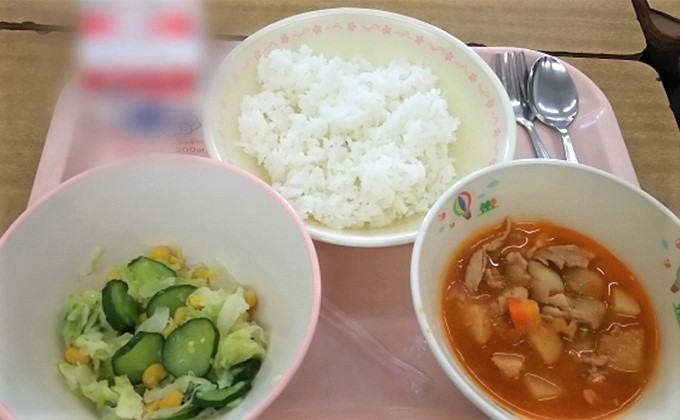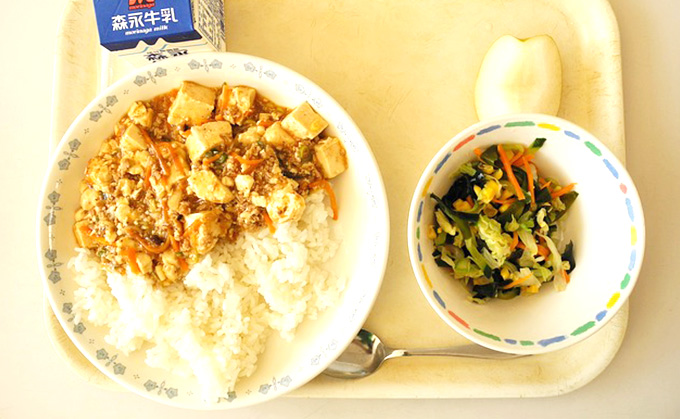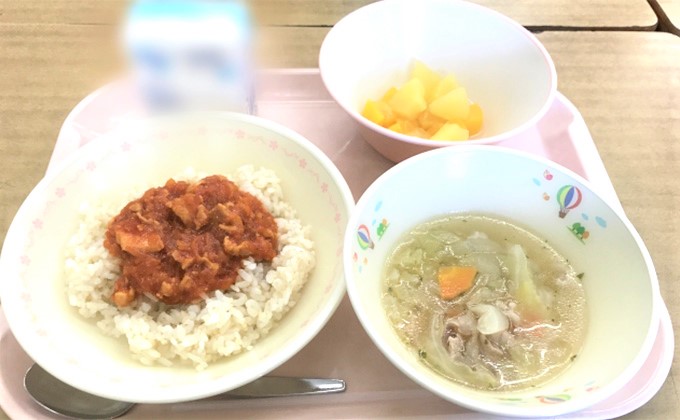TRG Info and Advice
Japanese and American School Lunch: Contents and Culture
What’s on the Menu?
School lunches in Japan tend to reflect the country’s homogenous food culture and include rice, rice-flour bread or noodles, soup, a main dish of fish or meat, one or two side dishes that are heavy on the veggies and legumes, milk, and, on special occasions only, dessert (cake at Christmas, star jellies for the Milky Way Lovers Festival, sweet rice cakes for Children’s Day, etc.). There are daily efforts to utilize locally produced rice, veggies, fish and milk. Attention is also paid to seasonally appropriate items like wild vegetable tempura in spring, summer vegetable curry in summer, sweet potatoes in the fall, and yellowtail cutlets in the winter.
Traditional Japanese food is some of the healthiest stuff in the world, and school lunches exhibit a serious effort to maintain that cultural palate. In Japan, many people believe that the flavors you desire most throughout your life are the ones you experience in the first three years. Stay-at-home parents and nursery schools that take care of very young children pay special attention to serving healthy, natural flavors without extra salt and sugar (i.e. plain rice porridge, fresh fruits, dried sweet potatoes, vegetable based crackers, barley tea, and so on).
Nutritionists are not opposed to utilizing an opportunity to try dishes from around the world, though. Sporting events like the Olympics and the World Cup often inspire menu planners to include famous foods of other countries, like Russian borscht or Brazilian beans and rice.
In the US, students can usually pick one of two entrees, usually a protein/carb mash-up like pizza pockets, a hamburger or pasta. They can choose from chocolate, strawberry or plain milk, and some schools with a high percentage of lactose-intolerant kids provide orange juice instead. Raw vegetables like lettuce, broccoli, carrots, cauliflower and celery are offered on most days and usually with a choice of dressings. A side dish like baked beans may be found, too. Dessert comes in the form of fruit or fruit-based sweets like cinnamon applesauce. American lunches sometimes include store-bought bagged items like chips and cookies. Some schools in the US also provide breakfast, after school snacks and even dinner!
In compliance with the School Meal Law, Japanese school lunches are planned by a nutritionist who is often also a trained instructor in health education. Nutritional information about every meal is published along with the monthly menu. The shokuiku curriculum ensures that students are provided with classes on making healthy food choices, nutrition and the creation of balanced meals.
While there may not be an onsite nutritionist, schools in the US who want to participate in the USDA Free Lunch program must comply with government regulated nutritional standards, and, through membership in Team Nutrition, can receive advice and recipe ideas on how to make school lunches healthier. Menu planners and other administrators can get apps for ordering food online, eat-your-veggies inspiring worksheets, and have access to forums for any questions and concerns regarding the school lunch program. Some schools have even outlined policies for the contents of lunches brought from home in order to comply with government standards.
Through the efforts of former FLOTUS Michelle Obama, the US Nutrition Standards for School Meals legislature calls for lower sodium and fewer trans-fats, more fresh-fruit and vegetable options, and whole grains. Reinforcing these new expectations, however, is proving to be rather difficult. Taste wise, these new school lunch menus contain foods that students are unfamiliar with and many are tossing out the precious fruits and veggies!
But, is it the contents of the lunches, or the entire attitude towards food in Japan? I’d say it’s both. In a typical Japanese school lunch, you can find veggies in almost everything: the soup, the side-dish and the entrée, whereas vegetables in the US tend to be more segregated. Japanese veggies are prepared in a variety of ways, too: pickled, boiled, sautéed, simmered, and steamed, but hardly ever fresh. American veggie side dishes, on the other hand, are usually mixed with butter and salt, or slathered in Ranch dressing to make them palatable.
Attitude!
This brings up a second point of comparison between school lunches in the US and Japan: attitude. Japanese culture has a strong sense of mottainai, the aversion to wasting anything, but especially food. The general expectation that what is served will be consumed makes school lunch in Japan seem ethically advanced. How did this attitude come to be so ingrained in Japanese culture? Many point to the food crisis experiences after WWII being passed down by modern day grandparents and great-grandparents. Of course, knowing what it’s like to be truly hungry makes people appreciate food more. Wasting food for the sake of your own preferences, therefore, is severely frowned upon in Japan. Picky kids are poster children for everything that is wrong with society, while those who consistently have sunshine plates are models of health and good citizenship.
Compare Japan’s mottainai attitude with what goes into an American school cafeteria garbage can! Even when the lunch staff make an effort to provide healthier choices, students don’t feel an obligation to clean their plates, and have the option of bringing lunch from home, as well. That often means serious waste on a variety of levels. In Japan, lunches are usually only brought from home for field trips or sports excursions, and for the all-school Sports Day Festival.
Luckily, getting students involved in growing and preparing school lunch, as well as raising awareness about the advantages of organic and locally grown goods has slowly been gaining popularity in the States. In an effort to get kids used to the new fruits and veggies appearing on their lunch trays, DC Central Kitchen has started Fresh Feature Friday where it prepares “new” items such as zucchini in three different ways, then lets kids taste them and vote for their favorite style.
Another way some superintendents and community leaders in the US are trying to combat this waste is by offering things like spices and sauces to let kids doctor up the fare. A few have even invited local chefs in for cooking workshops or mini Iron Chef Competitions, started school gardens where kids use the food they grow in their lunches, or implemented Farm to School programs focusing on local produce.
Personal involvement in the preparation of their food may be one of the reasons Japanese kids feel an obligation to clean their plates. Hopefully, creating a stronger connection between students and the food they eat will increase that feeling in the USA, too.









